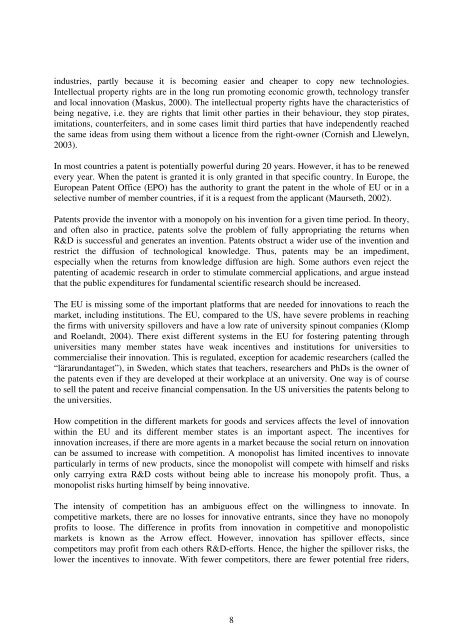INNOVATION POLICY INSTRUMENTS
INNOVATION POLICY INSTRUMENTS
INNOVATION POLICY INSTRUMENTS
Create successful ePaper yourself
Turn your PDF publications into a flip-book with our unique Google optimized e-Paper software.
industries, partly because it is becoming easier and cheaper to copy new technologies.<br />
Intellectual property rights are in the long run promoting economic growth, technology transfer<br />
and local innovation (Maskus, 2000). The intellectual property rights have the characteristics of<br />
being negative, i.e. they are rights that limit other parties in their behaviour, they stop pirates,<br />
imitations, counterfeiters, and in some cases limit third parties that have independently reached<br />
the same ideas from using them without a licence from the right-owner (Cornish and Llewelyn,<br />
2003).<br />
In most countries a patent is potentially powerful during 20 years. However, it has to be renewed<br />
every year. When the patent is granted it is only granted in that specific country. In Europe, the<br />
European Patent Office (EPO) has the authority to grant the patent in the whole of EU or in a<br />
selective number of member countries, if it is a request from the applicant (Maurseth, 2002).<br />
Patents provide the inventor with a monopoly on his invention for a given time period. In theory,<br />
and often also in practice, patents solve the problem of fully appropriating the returns when<br />
R&D is successful and generates an invention. Patents obstruct a wider use of the invention and<br />
restrict the diffusion of technological knowledge. Thus, patents may be an impediment,<br />
especially when the returns from knowledge diffusion are high. Some authors even reject the<br />
patenting of academic research in order to stimulate commercial applications, and argue instead<br />
that the public expenditures for fundamental scientific research should be increased.<br />
The EU is missing some of the important platforms that are needed for innovations to reach the<br />
market, including institutions. The EU, compared to the US, have severe problems in reaching<br />
the firms with university spillovers and have a low rate of university spinout companies (Klomp<br />
and Roelandt, 2004). There exist different systems in the EU for fostering patenting through<br />
universities many member states have weak incentives and institutions for universities to<br />
commercialise their innovation. This is regulated, exception for academic researchers (called the<br />
“lärarundantaget”), in Sweden, which states that teachers, researchers and PhDs is the owner of<br />
the patents even if they are developed at their workplace at an university. One way is of course<br />
to sell the patent and receive financial compensation. In the US universities the patents belong to<br />
the universities.<br />
How competition in the different markets for goods and services affects the level of innovation<br />
within the EU and its different member states is an important aspect. The incentives for<br />
innovation increases, if there are more agents in a market because the social return on innovation<br />
can be assumed to increase with competition. A monopolist has limited incentives to innovate<br />
particularly in terms of new products, since the monopolist will compete with himself and risks<br />
only carrying extra R&D costs without being able to increase his monopoly profit. Thus, a<br />
monopolist risks hurting himself by being innovative.<br />
The intensity of competition has an ambiguous effect on the willingness to innovate. In<br />
competitive markets, there are no losses for innovative entrants, since they have no monopoly<br />
profits to loose. The difference in profits from innovation in competitive and monopolistic<br />
markets is known as the Arrow effect. However, innovation has spillover effects, since<br />
competitors may profit from each others R&D-efforts. Hence, the higher the spillover risks, the<br />
lower the incentives to innovate. With fewer competitors, there are fewer potential free riders,<br />
8
















